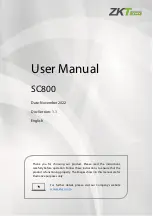
BAS-SVU025A-EN
33
Points
•
Binary inputs—These are typically two-state inputs, such as on/off or alarm/normal. Binary
inputs are generated by switching devices. Inputs points obtain their value from a selected
referencer. Input points are typically used to read values from other controllers such as LonTalk
devices or unit controller input points.
•
Binary outputs—These points are typically used to turn devices on or off. Binary outputs can
be controlled and overridden by using priority control.
•
Binary values—These points can only be true or false. Binary values do not contain referencers
but can be controlled and overridden by using priority control. Value points are typically used
for calculated values or setpoints.
•
Multistate inputs—Multistate points have between 1 and 20 states. Text is displayed for each
state rather than a numerical value. Inputs points obtain their value from a selected referencer.
Input points are typically used to read values from other controllers such as LonTalk devices or
unit controller input points.
•
Multistate outputs—Multistate points have between 1 and 20 states.Text is displayed for each
state rather than a numerical value. Multistate outputs can send their values to a defined
referencer and can be controlled and overridden by using priority control. Multistate outputs
are typically setpoints that are sent to controllers such as occupancy or heat cool mode request
on LonTalk controllers.
•
Multistate values—Multistate points have between 1 and 20 states. Text is displayed for each
state rather than a numerical value. Multistate values do not contain referencers but can be
controlled and overridden by using priority control. Multistate values are typically calculated
values in controllers or applications such as such as occupancy status or heat cool mode status.














































